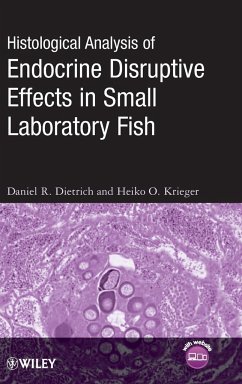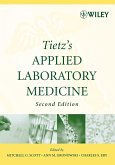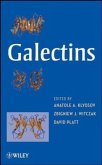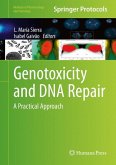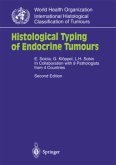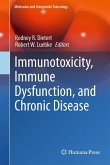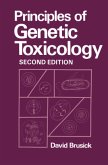- Gebundenes Buch
- Merkliste
- Auf die Merkliste
- Bewerten Bewerten
- Teilen
- Produkt teilen
- Produkterinnerung
- Produkterinnerung
Clarifying much of the inconsistency currently encountered in the scientific literature, Histology and Histopathological Analysis of Endocrine Disruptive Effects on Small Laboratory Fish helps to standardize the interpretation of results from aquatic bioassays and field observations by describing basic biological function and contrasting normal histology with histopathological conditions in a variety of fish species. The authors represent the leaders of small fish gonadal histopathology, and they incorporate views and ideas from other experts.
Timely title assembling the combined knowledge…mehr
Andere Kunden interessierten sich auch für
![Tietz's Applied Laboratory Medicine Tietz's Applied Laboratory Medicine]() Mitchell G. Scott / Ann M. Gronowski / Charles S. Eby / Norbert W. Tietz (eds.)Tietz's Applied Laboratory Medicine130,99 €
Mitchell G. Scott / Ann M. Gronowski / Charles S. Eby / Norbert W. Tietz (eds.)Tietz's Applied Laboratory Medicine130,99 €![Galectins Galectins]() Galectins193,99 €
Galectins193,99 €![Genotoxicity and DNA Repair Genotoxicity and DNA Repair]() Genotoxicity and DNA Repair117,99 €
Genotoxicity and DNA Repair117,99 €![Histological Typing of Endocrine Tumours Histological Typing of Endocrine Tumours]() Enrico SolciaHistological Typing of Endocrine Tumours41,99 €
Enrico SolciaHistological Typing of Endocrine Tumours41,99 €![Immunotoxicity, Immune Dysfunction, and Chronic Disease Immunotoxicity, Immune Dysfunction, and Chronic Disease]() Immunotoxicity, Immune Dysfunction, and Chronic Disease116,99 €
Immunotoxicity, Immune Dysfunction, and Chronic Disease116,99 €![Molecular Toxicology Protocols Molecular Toxicology Protocols]() Molecular Toxicology Protocols155,99 €
Molecular Toxicology Protocols155,99 €![Principles of Genetic Toxicology Principles of Genetic Toxicology]() D. BrusickPrinciples of Genetic Toxicology81,99 €
D. BrusickPrinciples of Genetic Toxicology81,99 €-
-
-
Clarifying much of the inconsistency currently encountered in the scientific literature, Histology and Histopathological Analysis of Endocrine Disruptive Effects on Small Laboratory Fish helps to standardize the interpretation of results from aquatic bioassays and field observations by describing basic biological function and contrasting normal histology with histopathological conditions in a variety of fish species. The authors represent the leaders of small fish gonadal histopathology, and they incorporate views and ideas from other experts.
Timely title assembling the combined knowledge of some of the leading authorities in the field of small fish reproduction - an important topic for risk assessment and registration of chemical, agricultural, and pharmaceutical compounds
Provides guidance on the microscopic structure of living tissue and evaluation of the reproductive glands of small laboratory fish
Includes state-of-the-art science along with sufficient anatomical and physiological background for understanding and interpreting test results
Helps standardize the interpretation of results from aquatic bioassays and field observations, which will also clarify inconsistencies in the current scientific literature
Note: CD-ROM/DVD and other supplementary materials are not included as part of eBook file.
Hinweis: Dieser Artikel kann nur an eine deutsche Lieferadresse ausgeliefert werden.
Timely title assembling the combined knowledge of some of the leading authorities in the field of small fish reproduction - an important topic for risk assessment and registration of chemical, agricultural, and pharmaceutical compounds
Provides guidance on the microscopic structure of living tissue and evaluation of the reproductive glands of small laboratory fish
Includes state-of-the-art science along with sufficient anatomical and physiological background for understanding and interpreting test results
Helps standardize the interpretation of results from aquatic bioassays and field observations, which will also clarify inconsistencies in the current scientific literature
Note: CD-ROM/DVD and other supplementary materials are not included as part of eBook file.
Hinweis: Dieser Artikel kann nur an eine deutsche Lieferadresse ausgeliefert werden.
Produktdetails
- Produktdetails
- Verlag: Wiley & Sons
- 1. Auflage
- Seitenzahl: 388
- Erscheinungstermin: 1. Juni 2008
- Englisch
- Abmessung: 240mm x 161mm x 25mm
- Gewicht: 684g
- ISBN-13: 9780471763581
- ISBN-10: 0471763586
- Artikelnr.: 23426199
- Herstellerkennzeichnung
- Libri GmbH
- Europaallee 1
- 36244 Bad Hersfeld
- gpsr@libri.de
- Verlag: Wiley & Sons
- 1. Auflage
- Seitenzahl: 388
- Erscheinungstermin: 1. Juni 2008
- Englisch
- Abmessung: 240mm x 161mm x 25mm
- Gewicht: 684g
- ISBN-13: 9780471763581
- ISBN-10: 0471763586
- Artikelnr.: 23426199
- Herstellerkennzeichnung
- Libri GmbH
- Europaallee 1
- 36244 Bad Hersfeld
- gpsr@libri.de
Daniel R. Dietrich, PhD, is a Professor and Head of the Human and Environmental Toxicology Group, Faculty of Sciences of the University of Konstanz, Konstanz, Germany. Heiko O. Krieger, MSc, is a scientific research assistant and PhD student in the Human and Environmental Toxicology Group, Faculty of Sciences of the University of Konstanz, Konstanz, Germany.
Preface xi
Acknowledgments xiii
Contributing Authors xv
1 Introduction 1
References 3
2 Fish Species of Interest 7
2.1 Fathead Minnow (Pimephales promelas) 8
2.2 Medaka (Oryzias latipes) 10
2.3 Zebrafish (Danio rerio) 12
2.4 Other Fish Species 13
References 15
3 Sexual Determination, Differentiation, and Gonadal Development 19
3.1 Primordial Germ Cells in the Primordial (Primary) Gonad 22
3.1.1 Differentiation and Number of PGCs 22
3.1.2 Molecular Markers of PGCs 25
3.2 Reproductive Strategies 26
3.3 Differentiation of the Primordial Gonad into Ovary or Testis 27
3.4 Gonadal Duct Formation 32
3.5 Endocrinology: Influence on Gonadogenesis 40
3.6 Critical Period of Sexual Differentiation in Developing Fish 45
3.7 Bi-Potentiality of Germ Cells in Adult Fish 47
References 51
4 Female Gonad Anatomy and Morphology 66
4.1 Gonadogenesis: Ovary 66
4.1.1 Location and Gross Organization 66
4.1.2 Anatomy of the Ovary 67
4.2 Hypothalamic-Pituitary-Ovarian Axis 69
4.3 Cellular Structure of the Ovary 69
4.3.1 Germ Cells (Oogenesis) 69
4.3.2 Female Somatic Supportive Tissue 78
4.3.2.1 Theca Cells 78
4.3.2.2 Granulosa Cells 81
References 81
5 Male Gonad Anatomy and Morphology 88
5.1 Gonadogenesis: Testes 88
5.1.1 Location and Gross Organization 88
5.1.2 Anatomy of the Testes 89
5.1.3 Germinal Epithelium 93
5.1.4 Male Germ Cells (Spermatogenesis) 95
5.1.5 Male Somatic Supportive Tissue 99
5.1.5.1 Sertoli Cells 99
5.1.5.2 Leydig Cells 103
5.1.5.3 Lobule Boundary Cells 104
5.1.5.4 Sex Steroid Control of Spermatogenesis 104
References 108
6 Endocrine-Disrupting Compounds 115
6.1 Individual Effects 117
6.1.1 Inhibition of Gametogenesis 117
6.1.2 Necrosis and Apoptosis (Gamete and Stromal Cells) 119
6.1.3 Atretic Follicles 121
6.1.4 Sertoli Cell Hypertrophy and Hyperplasia 123
6.1.5 Leydig Cell Hypertrophy and Hyperplasia 129
6.1.6 Fibrosis 129
6.1.7 Gonadal Duct Formation 132
6.2 Effects Associated with Exposure to Specific
Compounds or Compound Classes 133
Table 6.1 Overt Testicular Changes in Male Fish, 134
Table 6.2 Testis-Ova in Male Fish, 148
Table 6.3 Testicular Fibrosis in Male Fish, 161
Table 6.4 Germ Cell Effects in Male Fish, 165
Table 6.5 Somatic Cell Effects in Male Fish, 181
Table 6.6 Testicular Inflammation and Macrophage
Infiltration in Male Fish, 186
Table 6.7 Overt Ovarian Changes in Female Fish, 187
Table 6.8 Ovo-Testis in Female Fish, 195
Table 6.9 Ovarian Fibrosis in Female Fish, 196
Table 6.10 Germ Cell Effects in Female Fish, 197
Table 6.11 Germ Cell Atresia in Female Fish, 206
Table 6.12 Ovarian Inflammation and Macrophage Infiltration in Female Fish,
214
6.2.1 Effects in Male Fish Associated with Exposure to Specific Compounds
or Compound Classes 215
6.2.1.1 Testis Architecture, Integrity, and Gross Appearance 215
6.2.1.2 Testis-Ova 215
6.2.1.3 Fibrosis 216
6.2.1.4 Germ Cell Effects 217
6.2.1.5 Somatic Cell Effects 219
6.2.1.6 Testicular Cell Inflammation and Macrophage Infiltration 219
6.2.2 Effects in Female Fish Associated with Exposure to Specific Compounds
or Compound Classes 220
6.2.2.1 Ovary Architecture, Integrity, and Gross Appearance 220
6.2.2.2 Ovo-Testis 221
6.2.2.3 Fibrosis 221
6.2.2.4 Germ Cell Effects 222
6.2.2.5 Germ Cell Atresia 223
6.2.2.6 Germ Cell Inflammation and Macrophage Infiltration 225
6.3 Population Effects 225
6.3.1 Fecundity and Fertility 226
6.3.2 Breeding and Reproductive Behavior of Fishes 230
6.3.3 Transgenerational Effects 230
References 232
7 Determination of Effects of Exogenous Hormones and Endocrine-like Active
Compounds 247
7.1 Histological Processing: Microdissection versus Whole-Fish Sectioning
247
7.2 Optimal Tissue Preparation and Histological Techniques 250
7.3 Plane of Gonad Sectioning for Optimal Organ Representation 251
References 252
8 Evaluation of Effects in Fish Gonads 254
8.1 Qualitative (Semiquantitative) versus Quantitative Evaluation 254
8.2 Gonadal Staging in the Testis 255
8.2.1 Qualitative Staging in the Testis 255
8.2.2 Quantitative Staging in the Testis 257
8.3 Gonadal Staging in the Ovary 262
8.3.1 Qualitative Staging in the Ovary 262
8.3.2 Quantitative Staging in the Ovary 264
8.4 Qualitative Assessment of Histopathological Changes 265
References 267
9 Experimental Design and Statistics 270
9.1 Basic Considerations in Experimental Design 270
9.1.1 Defining the Objectives 271
9.1.2 Asking Precise Questions 271
9.1.3 The Principal Question: Is There an Effect or Is There Not? 272
9.1.4 Basic Mechanistic Research, Risk Assessment, and the NOEC, LOEC, and
ECx Question 272
9.2 Variables to be Determined and Their Inherent Biological and
Mathematical Characteristics 274
9.2.1 Biological Characteristics 274
9.2.2 Mathematical Characteristics 278
9.3 Prerequisite Statistical Concepts 282
9.3.1 Sample Independence: The Experimental Unit 282
9.3.2 One- or Two-Sided Testing 283
9.3.3 Observable Effect Size: Minimum Observable Effect 283
9.3.4 Power (1 b) to Detect an Effect 284
9.3.5 Replication and Pseudoreplication 286
9.3.6 Minimum Significant Difference 287
9.4 Statistical Tests and Testing Situations Encountered Routinely 288
9.4.1 Significance Level of Multiple Comparisons: Variable-wise
Significance 288
9.4.2 Significance Level for Many Different Comparisons: Simultaneous
Significance 288
9.4.3 Multivariate Tests 289
9.4.4 Parametric Versus Nonparametric Testing 289
References 289
10 Conclusions 295
References 297
Appendix: Fish Preparation and Microdissection of Organs 301
A.1 Fish Preparation 301
A.2 Microdissection of Organs 302
A.3 Tissue Fixation 303
A.3.1 Neutral Buffered Formalin 304
A.3.2 Bouin's Fixative 304
A.3.3 Lillie's Fixative 305
A.3.4 Davidson's Fixative 305
A.3.5 Dietrich's Fixative 306
A.3.6 Glutaraldehyde 306
A.4 Embedding 307
A.4.1 Paraffin 307
A.4.2 Glycolmethacrylate (GMA) 309
A.5 Tissue Sectioning 310
A.6 Sample Mounting 311
A.7 Tissue Slide Staining 312
A.7.1 Hematoxylin and Eosin 312
A.7.2 Masson's Trichrome Stain 314
A.8 Final Processing 315
A.9 Examples 316
A.10 Summary 317
References 318
Index 319
Acknowledgments xiii
Contributing Authors xv
1 Introduction 1
References 3
2 Fish Species of Interest 7
2.1 Fathead Minnow (Pimephales promelas) 8
2.2 Medaka (Oryzias latipes) 10
2.3 Zebrafish (Danio rerio) 12
2.4 Other Fish Species 13
References 15
3 Sexual Determination, Differentiation, and Gonadal Development 19
3.1 Primordial Germ Cells in the Primordial (Primary) Gonad 22
3.1.1 Differentiation and Number of PGCs 22
3.1.2 Molecular Markers of PGCs 25
3.2 Reproductive Strategies 26
3.3 Differentiation of the Primordial Gonad into Ovary or Testis 27
3.4 Gonadal Duct Formation 32
3.5 Endocrinology: Influence on Gonadogenesis 40
3.6 Critical Period of Sexual Differentiation in Developing Fish 45
3.7 Bi-Potentiality of Germ Cells in Adult Fish 47
References 51
4 Female Gonad Anatomy and Morphology 66
4.1 Gonadogenesis: Ovary 66
4.1.1 Location and Gross Organization 66
4.1.2 Anatomy of the Ovary 67
4.2 Hypothalamic-Pituitary-Ovarian Axis 69
4.3 Cellular Structure of the Ovary 69
4.3.1 Germ Cells (Oogenesis) 69
4.3.2 Female Somatic Supportive Tissue 78
4.3.2.1 Theca Cells 78
4.3.2.2 Granulosa Cells 81
References 81
5 Male Gonad Anatomy and Morphology 88
5.1 Gonadogenesis: Testes 88
5.1.1 Location and Gross Organization 88
5.1.2 Anatomy of the Testes 89
5.1.3 Germinal Epithelium 93
5.1.4 Male Germ Cells (Spermatogenesis) 95
5.1.5 Male Somatic Supportive Tissue 99
5.1.5.1 Sertoli Cells 99
5.1.5.2 Leydig Cells 103
5.1.5.3 Lobule Boundary Cells 104
5.1.5.4 Sex Steroid Control of Spermatogenesis 104
References 108
6 Endocrine-Disrupting Compounds 115
6.1 Individual Effects 117
6.1.1 Inhibition of Gametogenesis 117
6.1.2 Necrosis and Apoptosis (Gamete and Stromal Cells) 119
6.1.3 Atretic Follicles 121
6.1.4 Sertoli Cell Hypertrophy and Hyperplasia 123
6.1.5 Leydig Cell Hypertrophy and Hyperplasia 129
6.1.6 Fibrosis 129
6.1.7 Gonadal Duct Formation 132
6.2 Effects Associated with Exposure to Specific
Compounds or Compound Classes 133
Table 6.1 Overt Testicular Changes in Male Fish, 134
Table 6.2 Testis-Ova in Male Fish, 148
Table 6.3 Testicular Fibrosis in Male Fish, 161
Table 6.4 Germ Cell Effects in Male Fish, 165
Table 6.5 Somatic Cell Effects in Male Fish, 181
Table 6.6 Testicular Inflammation and Macrophage
Infiltration in Male Fish, 186
Table 6.7 Overt Ovarian Changes in Female Fish, 187
Table 6.8 Ovo-Testis in Female Fish, 195
Table 6.9 Ovarian Fibrosis in Female Fish, 196
Table 6.10 Germ Cell Effects in Female Fish, 197
Table 6.11 Germ Cell Atresia in Female Fish, 206
Table 6.12 Ovarian Inflammation and Macrophage Infiltration in Female Fish,
214
6.2.1 Effects in Male Fish Associated with Exposure to Specific Compounds
or Compound Classes 215
6.2.1.1 Testis Architecture, Integrity, and Gross Appearance 215
6.2.1.2 Testis-Ova 215
6.2.1.3 Fibrosis 216
6.2.1.4 Germ Cell Effects 217
6.2.1.5 Somatic Cell Effects 219
6.2.1.6 Testicular Cell Inflammation and Macrophage Infiltration 219
6.2.2 Effects in Female Fish Associated with Exposure to Specific Compounds
or Compound Classes 220
6.2.2.1 Ovary Architecture, Integrity, and Gross Appearance 220
6.2.2.2 Ovo-Testis 221
6.2.2.3 Fibrosis 221
6.2.2.4 Germ Cell Effects 222
6.2.2.5 Germ Cell Atresia 223
6.2.2.6 Germ Cell Inflammation and Macrophage Infiltration 225
6.3 Population Effects 225
6.3.1 Fecundity and Fertility 226
6.3.2 Breeding and Reproductive Behavior of Fishes 230
6.3.3 Transgenerational Effects 230
References 232
7 Determination of Effects of Exogenous Hormones and Endocrine-like Active
Compounds 247
7.1 Histological Processing: Microdissection versus Whole-Fish Sectioning
247
7.2 Optimal Tissue Preparation and Histological Techniques 250
7.3 Plane of Gonad Sectioning for Optimal Organ Representation 251
References 252
8 Evaluation of Effects in Fish Gonads 254
8.1 Qualitative (Semiquantitative) versus Quantitative Evaluation 254
8.2 Gonadal Staging in the Testis 255
8.2.1 Qualitative Staging in the Testis 255
8.2.2 Quantitative Staging in the Testis 257
8.3 Gonadal Staging in the Ovary 262
8.3.1 Qualitative Staging in the Ovary 262
8.3.2 Quantitative Staging in the Ovary 264
8.4 Qualitative Assessment of Histopathological Changes 265
References 267
9 Experimental Design and Statistics 270
9.1 Basic Considerations in Experimental Design 270
9.1.1 Defining the Objectives 271
9.1.2 Asking Precise Questions 271
9.1.3 The Principal Question: Is There an Effect or Is There Not? 272
9.1.4 Basic Mechanistic Research, Risk Assessment, and the NOEC, LOEC, and
ECx Question 272
9.2 Variables to be Determined and Their Inherent Biological and
Mathematical Characteristics 274
9.2.1 Biological Characteristics 274
9.2.2 Mathematical Characteristics 278
9.3 Prerequisite Statistical Concepts 282
9.3.1 Sample Independence: The Experimental Unit 282
9.3.2 One- or Two-Sided Testing 283
9.3.3 Observable Effect Size: Minimum Observable Effect 283
9.3.4 Power (1 b) to Detect an Effect 284
9.3.5 Replication and Pseudoreplication 286
9.3.6 Minimum Significant Difference 287
9.4 Statistical Tests and Testing Situations Encountered Routinely 288
9.4.1 Significance Level of Multiple Comparisons: Variable-wise
Significance 288
9.4.2 Significance Level for Many Different Comparisons: Simultaneous
Significance 288
9.4.3 Multivariate Tests 289
9.4.4 Parametric Versus Nonparametric Testing 289
References 289
10 Conclusions 295
References 297
Appendix: Fish Preparation and Microdissection of Organs 301
A.1 Fish Preparation 301
A.2 Microdissection of Organs 302
A.3 Tissue Fixation 303
A.3.1 Neutral Buffered Formalin 304
A.3.2 Bouin's Fixative 304
A.3.3 Lillie's Fixative 305
A.3.4 Davidson's Fixative 305
A.3.5 Dietrich's Fixative 306
A.3.6 Glutaraldehyde 306
A.4 Embedding 307
A.4.1 Paraffin 307
A.4.2 Glycolmethacrylate (GMA) 309
A.5 Tissue Sectioning 310
A.6 Sample Mounting 311
A.7 Tissue Slide Staining 312
A.7.1 Hematoxylin and Eosin 312
A.7.2 Masson's Trichrome Stain 314
A.8 Final Processing 315
A.9 Examples 316
A.10 Summary 317
References 318
Index 319
Preface xi
Acknowledgments xiii
Contributing Authors xv
1 Introduction 1
References 3
2 Fish Species of Interest 7
2.1 Fathead Minnow (Pimephales promelas) 8
2.2 Medaka (Oryzias latipes) 10
2.3 Zebrafish (Danio rerio) 12
2.4 Other Fish Species 13
References 15
3 Sexual Determination, Differentiation, and Gonadal Development 19
3.1 Primordial Germ Cells in the Primordial (Primary) Gonad 22
3.1.1 Differentiation and Number of PGCs 22
3.1.2 Molecular Markers of PGCs 25
3.2 Reproductive Strategies 26
3.3 Differentiation of the Primordial Gonad into Ovary or Testis 27
3.4 Gonadal Duct Formation 32
3.5 Endocrinology: Influence on Gonadogenesis 40
3.6 Critical Period of Sexual Differentiation in Developing Fish 45
3.7 Bi-Potentiality of Germ Cells in Adult Fish 47
References 51
4 Female Gonad Anatomy and Morphology 66
4.1 Gonadogenesis: Ovary 66
4.1.1 Location and Gross Organization 66
4.1.2 Anatomy of the Ovary 67
4.2 Hypothalamic-Pituitary-Ovarian Axis 69
4.3 Cellular Structure of the Ovary 69
4.3.1 Germ Cells (Oogenesis) 69
4.3.2 Female Somatic Supportive Tissue 78
4.3.2.1 Theca Cells 78
4.3.2.2 Granulosa Cells 81
References 81
5 Male Gonad Anatomy and Morphology 88
5.1 Gonadogenesis: Testes 88
5.1.1 Location and Gross Organization 88
5.1.2 Anatomy of the Testes 89
5.1.3 Germinal Epithelium 93
5.1.4 Male Germ Cells (Spermatogenesis) 95
5.1.5 Male Somatic Supportive Tissue 99
5.1.5.1 Sertoli Cells 99
5.1.5.2 Leydig Cells 103
5.1.5.3 Lobule Boundary Cells 104
5.1.5.4 Sex Steroid Control of Spermatogenesis 104
References 108
6 Endocrine-Disrupting Compounds 115
6.1 Individual Effects 117
6.1.1 Inhibition of Gametogenesis 117
6.1.2 Necrosis and Apoptosis (Gamete and Stromal Cells) 119
6.1.3 Atretic Follicles 121
6.1.4 Sertoli Cell Hypertrophy and Hyperplasia 123
6.1.5 Leydig Cell Hypertrophy and Hyperplasia 129
6.1.6 Fibrosis 129
6.1.7 Gonadal Duct Formation 132
6.2 Effects Associated with Exposure to Specific
Compounds or Compound Classes 133
Table 6.1 Overt Testicular Changes in Male Fish, 134
Table 6.2 Testis-Ova in Male Fish, 148
Table 6.3 Testicular Fibrosis in Male Fish, 161
Table 6.4 Germ Cell Effects in Male Fish, 165
Table 6.5 Somatic Cell Effects in Male Fish, 181
Table 6.6 Testicular Inflammation and Macrophage
Infiltration in Male Fish, 186
Table 6.7 Overt Ovarian Changes in Female Fish, 187
Table 6.8 Ovo-Testis in Female Fish, 195
Table 6.9 Ovarian Fibrosis in Female Fish, 196
Table 6.10 Germ Cell Effects in Female Fish, 197
Table 6.11 Germ Cell Atresia in Female Fish, 206
Table 6.12 Ovarian Inflammation and Macrophage Infiltration in Female Fish,
214
6.2.1 Effects in Male Fish Associated with Exposure to Specific Compounds
or Compound Classes 215
6.2.1.1 Testis Architecture, Integrity, and Gross Appearance 215
6.2.1.2 Testis-Ova 215
6.2.1.3 Fibrosis 216
6.2.1.4 Germ Cell Effects 217
6.2.1.5 Somatic Cell Effects 219
6.2.1.6 Testicular Cell Inflammation and Macrophage Infiltration 219
6.2.2 Effects in Female Fish Associated with Exposure to Specific Compounds
or Compound Classes 220
6.2.2.1 Ovary Architecture, Integrity, and Gross Appearance 220
6.2.2.2 Ovo-Testis 221
6.2.2.3 Fibrosis 221
6.2.2.4 Germ Cell Effects 222
6.2.2.5 Germ Cell Atresia 223
6.2.2.6 Germ Cell Inflammation and Macrophage Infiltration 225
6.3 Population Effects 225
6.3.1 Fecundity and Fertility 226
6.3.2 Breeding and Reproductive Behavior of Fishes 230
6.3.3 Transgenerational Effects 230
References 232
7 Determination of Effects of Exogenous Hormones and Endocrine-like Active
Compounds 247
7.1 Histological Processing: Microdissection versus Whole-Fish Sectioning
247
7.2 Optimal Tissue Preparation and Histological Techniques 250
7.3 Plane of Gonad Sectioning for Optimal Organ Representation 251
References 252
8 Evaluation of Effects in Fish Gonads 254
8.1 Qualitative (Semiquantitative) versus Quantitative Evaluation 254
8.2 Gonadal Staging in the Testis 255
8.2.1 Qualitative Staging in the Testis 255
8.2.2 Quantitative Staging in the Testis 257
8.3 Gonadal Staging in the Ovary 262
8.3.1 Qualitative Staging in the Ovary 262
8.3.2 Quantitative Staging in the Ovary 264
8.4 Qualitative Assessment of Histopathological Changes 265
References 267
9 Experimental Design and Statistics 270
9.1 Basic Considerations in Experimental Design 270
9.1.1 Defining the Objectives 271
9.1.2 Asking Precise Questions 271
9.1.3 The Principal Question: Is There an Effect or Is There Not? 272
9.1.4 Basic Mechanistic Research, Risk Assessment, and the NOEC, LOEC, and
ECx Question 272
9.2 Variables to be Determined and Their Inherent Biological and
Mathematical Characteristics 274
9.2.1 Biological Characteristics 274
9.2.2 Mathematical Characteristics 278
9.3 Prerequisite Statistical Concepts 282
9.3.1 Sample Independence: The Experimental Unit 282
9.3.2 One- or Two-Sided Testing 283
9.3.3 Observable Effect Size: Minimum Observable Effect 283
9.3.4 Power (1 b) to Detect an Effect 284
9.3.5 Replication and Pseudoreplication 286
9.3.6 Minimum Significant Difference 287
9.4 Statistical Tests and Testing Situations Encountered Routinely 288
9.4.1 Significance Level of Multiple Comparisons: Variable-wise
Significance 288
9.4.2 Significance Level for Many Different Comparisons: Simultaneous
Significance 288
9.4.3 Multivariate Tests 289
9.4.4 Parametric Versus Nonparametric Testing 289
References 289
10 Conclusions 295
References 297
Appendix: Fish Preparation and Microdissection of Organs 301
A.1 Fish Preparation 301
A.2 Microdissection of Organs 302
A.3 Tissue Fixation 303
A.3.1 Neutral Buffered Formalin 304
A.3.2 Bouin's Fixative 304
A.3.3 Lillie's Fixative 305
A.3.4 Davidson's Fixative 305
A.3.5 Dietrich's Fixative 306
A.3.6 Glutaraldehyde 306
A.4 Embedding 307
A.4.1 Paraffin 307
A.4.2 Glycolmethacrylate (GMA) 309
A.5 Tissue Sectioning 310
A.6 Sample Mounting 311
A.7 Tissue Slide Staining 312
A.7.1 Hematoxylin and Eosin 312
A.7.2 Masson's Trichrome Stain 314
A.8 Final Processing 315
A.9 Examples 316
A.10 Summary 317
References 318
Index 319
Acknowledgments xiii
Contributing Authors xv
1 Introduction 1
References 3
2 Fish Species of Interest 7
2.1 Fathead Minnow (Pimephales promelas) 8
2.2 Medaka (Oryzias latipes) 10
2.3 Zebrafish (Danio rerio) 12
2.4 Other Fish Species 13
References 15
3 Sexual Determination, Differentiation, and Gonadal Development 19
3.1 Primordial Germ Cells in the Primordial (Primary) Gonad 22
3.1.1 Differentiation and Number of PGCs 22
3.1.2 Molecular Markers of PGCs 25
3.2 Reproductive Strategies 26
3.3 Differentiation of the Primordial Gonad into Ovary or Testis 27
3.4 Gonadal Duct Formation 32
3.5 Endocrinology: Influence on Gonadogenesis 40
3.6 Critical Period of Sexual Differentiation in Developing Fish 45
3.7 Bi-Potentiality of Germ Cells in Adult Fish 47
References 51
4 Female Gonad Anatomy and Morphology 66
4.1 Gonadogenesis: Ovary 66
4.1.1 Location and Gross Organization 66
4.1.2 Anatomy of the Ovary 67
4.2 Hypothalamic-Pituitary-Ovarian Axis 69
4.3 Cellular Structure of the Ovary 69
4.3.1 Germ Cells (Oogenesis) 69
4.3.2 Female Somatic Supportive Tissue 78
4.3.2.1 Theca Cells 78
4.3.2.2 Granulosa Cells 81
References 81
5 Male Gonad Anatomy and Morphology 88
5.1 Gonadogenesis: Testes 88
5.1.1 Location and Gross Organization 88
5.1.2 Anatomy of the Testes 89
5.1.3 Germinal Epithelium 93
5.1.4 Male Germ Cells (Spermatogenesis) 95
5.1.5 Male Somatic Supportive Tissue 99
5.1.5.1 Sertoli Cells 99
5.1.5.2 Leydig Cells 103
5.1.5.3 Lobule Boundary Cells 104
5.1.5.4 Sex Steroid Control of Spermatogenesis 104
References 108
6 Endocrine-Disrupting Compounds 115
6.1 Individual Effects 117
6.1.1 Inhibition of Gametogenesis 117
6.1.2 Necrosis and Apoptosis (Gamete and Stromal Cells) 119
6.1.3 Atretic Follicles 121
6.1.4 Sertoli Cell Hypertrophy and Hyperplasia 123
6.1.5 Leydig Cell Hypertrophy and Hyperplasia 129
6.1.6 Fibrosis 129
6.1.7 Gonadal Duct Formation 132
6.2 Effects Associated with Exposure to Specific
Compounds or Compound Classes 133
Table 6.1 Overt Testicular Changes in Male Fish, 134
Table 6.2 Testis-Ova in Male Fish, 148
Table 6.3 Testicular Fibrosis in Male Fish, 161
Table 6.4 Germ Cell Effects in Male Fish, 165
Table 6.5 Somatic Cell Effects in Male Fish, 181
Table 6.6 Testicular Inflammation and Macrophage
Infiltration in Male Fish, 186
Table 6.7 Overt Ovarian Changes in Female Fish, 187
Table 6.8 Ovo-Testis in Female Fish, 195
Table 6.9 Ovarian Fibrosis in Female Fish, 196
Table 6.10 Germ Cell Effects in Female Fish, 197
Table 6.11 Germ Cell Atresia in Female Fish, 206
Table 6.12 Ovarian Inflammation and Macrophage Infiltration in Female Fish,
214
6.2.1 Effects in Male Fish Associated with Exposure to Specific Compounds
or Compound Classes 215
6.2.1.1 Testis Architecture, Integrity, and Gross Appearance 215
6.2.1.2 Testis-Ova 215
6.2.1.3 Fibrosis 216
6.2.1.4 Germ Cell Effects 217
6.2.1.5 Somatic Cell Effects 219
6.2.1.6 Testicular Cell Inflammation and Macrophage Infiltration 219
6.2.2 Effects in Female Fish Associated with Exposure to Specific Compounds
or Compound Classes 220
6.2.2.1 Ovary Architecture, Integrity, and Gross Appearance 220
6.2.2.2 Ovo-Testis 221
6.2.2.3 Fibrosis 221
6.2.2.4 Germ Cell Effects 222
6.2.2.5 Germ Cell Atresia 223
6.2.2.6 Germ Cell Inflammation and Macrophage Infiltration 225
6.3 Population Effects 225
6.3.1 Fecundity and Fertility 226
6.3.2 Breeding and Reproductive Behavior of Fishes 230
6.3.3 Transgenerational Effects 230
References 232
7 Determination of Effects of Exogenous Hormones and Endocrine-like Active
Compounds 247
7.1 Histological Processing: Microdissection versus Whole-Fish Sectioning
247
7.2 Optimal Tissue Preparation and Histological Techniques 250
7.3 Plane of Gonad Sectioning for Optimal Organ Representation 251
References 252
8 Evaluation of Effects in Fish Gonads 254
8.1 Qualitative (Semiquantitative) versus Quantitative Evaluation 254
8.2 Gonadal Staging in the Testis 255
8.2.1 Qualitative Staging in the Testis 255
8.2.2 Quantitative Staging in the Testis 257
8.3 Gonadal Staging in the Ovary 262
8.3.1 Qualitative Staging in the Ovary 262
8.3.2 Quantitative Staging in the Ovary 264
8.4 Qualitative Assessment of Histopathological Changes 265
References 267
9 Experimental Design and Statistics 270
9.1 Basic Considerations in Experimental Design 270
9.1.1 Defining the Objectives 271
9.1.2 Asking Precise Questions 271
9.1.3 The Principal Question: Is There an Effect or Is There Not? 272
9.1.4 Basic Mechanistic Research, Risk Assessment, and the NOEC, LOEC, and
ECx Question 272
9.2 Variables to be Determined and Their Inherent Biological and
Mathematical Characteristics 274
9.2.1 Biological Characteristics 274
9.2.2 Mathematical Characteristics 278
9.3 Prerequisite Statistical Concepts 282
9.3.1 Sample Independence: The Experimental Unit 282
9.3.2 One- or Two-Sided Testing 283
9.3.3 Observable Effect Size: Minimum Observable Effect 283
9.3.4 Power (1 b) to Detect an Effect 284
9.3.5 Replication and Pseudoreplication 286
9.3.6 Minimum Significant Difference 287
9.4 Statistical Tests and Testing Situations Encountered Routinely 288
9.4.1 Significance Level of Multiple Comparisons: Variable-wise
Significance 288
9.4.2 Significance Level for Many Different Comparisons: Simultaneous
Significance 288
9.4.3 Multivariate Tests 289
9.4.4 Parametric Versus Nonparametric Testing 289
References 289
10 Conclusions 295
References 297
Appendix: Fish Preparation and Microdissection of Organs 301
A.1 Fish Preparation 301
A.2 Microdissection of Organs 302
A.3 Tissue Fixation 303
A.3.1 Neutral Buffered Formalin 304
A.3.2 Bouin's Fixative 304
A.3.3 Lillie's Fixative 305
A.3.4 Davidson's Fixative 305
A.3.5 Dietrich's Fixative 306
A.3.6 Glutaraldehyde 306
A.4 Embedding 307
A.4.1 Paraffin 307
A.4.2 Glycolmethacrylate (GMA) 309
A.5 Tissue Sectioning 310
A.6 Sample Mounting 311
A.7 Tissue Slide Staining 312
A.7.1 Hematoxylin and Eosin 312
A.7.2 Masson's Trichrome Stain 314
A.8 Final Processing 315
A.9 Examples 316
A.10 Summary 317
References 318
Index 319

